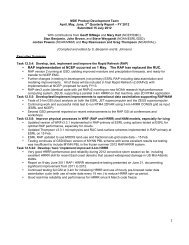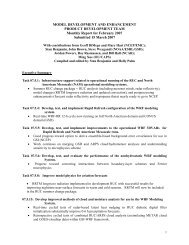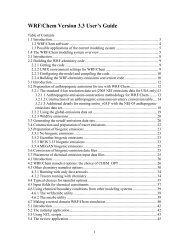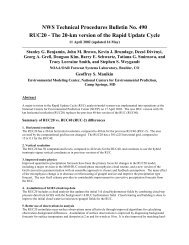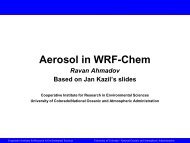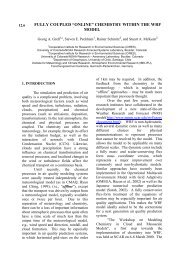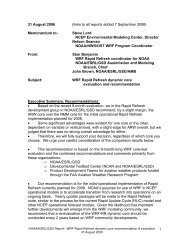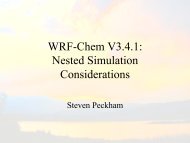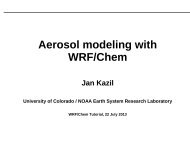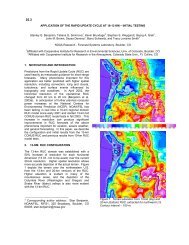WRF/Chem chemical mechanisms and KPP - RUC - NOAA
WRF/Chem chemical mechanisms and KPP - RUC - NOAA
WRF/Chem chemical mechanisms and KPP - RUC - NOAA
You also want an ePaper? Increase the reach of your titles
YUMPU automatically turns print PDFs into web optimized ePapers that Google loves.
<strong>Chem</strong>ical <strong>mechanisms</strong> <strong>and</strong> <strong>KPP</strong><br />
Ravan Ahmadov<br />
Cooperative Institute for Research in Environmental Sciences, CU Boulder<br />
Earth System Research Laboratory, <strong>NOAA</strong>, Boulder<br />
Acknowledgements: S.W.Kim, M.Salzmann, S.McKeen<br />
<strong>WRF</strong>-<strong>Chem</strong> tutorial, NCAR, July 18, 2011
Outline<br />
<br />
<strong>Chem</strong>ical <strong>mechanisms</strong> in the <strong>WRF</strong>-<strong>Chem</strong> model<br />
<br />
Kinetic PreProcessor (<strong>KPP</strong>) <strong>and</strong> <strong>WRF</strong>-<strong>Chem</strong> <strong>KPP</strong> Coupler (WKC)<br />
<br />
Adding <strong>chemical</strong> <strong>mechanisms</strong> to the <strong>WRF</strong>-<strong>Chem</strong> model using <strong>KPP</strong><br />
<br />
Suggestions<br />
2
Main gas phase chemistry <strong>mechanisms</strong> in <strong>WRF</strong>-<strong>Chem</strong>3.3<br />
<br />
<br />
<br />
<br />
<br />
<br />
<br />
<br />
<br />
<br />
Regional Acid Deposition Model, 2 nd generation (RADM2)<br />
Regional Atmospheric <strong>Chem</strong>istry Mechanism (RACM)<br />
RACM - Mainz Isoprene Mechanism (RACM-MIM)<br />
RACM - Earth System Research Laboratory (RACM-ESRL), updated RACM-MIM<br />
Carbon Bond Mechanism (CB4)<br />
Carbon-Bond Mechanism version Z (CBMZ)<br />
Model of Ozone <strong>and</strong> Related <strong>Chem</strong>ical Tracers (MOZART)<br />
Nonmethane Hydrocarbons <strong>Chem</strong>istry (NMHC9)<br />
Statewide Air Pollution Research Center (SAPRC99)<br />
RACM2 - ongoing work<br />
different implementations, coupled to different aerosol schemes <strong>and</strong> aqueous<br />
chemistry, suitable for different applications ranging from regional air quality to<br />
global atmospheric chemistry simulations (no halogen chemistry yet!)<br />
4
Some references<br />
<br />
Stockwell, W. R., et al. (1997), A new mechanism for regional atmospheric chemistry modeling, J. Geophys.<br />
Res.-Atmos., 102(D22), 25847-25879.<br />
<br />
Stockwell, W. R., et al. (1990), The 2nd generation regional acid deposition model <strong>chemical</strong> mechanism for<br />
regional air-quality modeling, J. Geophys. Res.-Atmos., 95(D10), 16343-16367.<br />
<br />
Horowitz, L. W., et al. (2003), A global simulation of tropospheric ozone <strong>and</strong> related tracers: Description <strong>and</strong><br />
evaluation of MOZART, version 2, J. Geophys. Res., 108(D24), 4784, doi:4710.1029/2002JD002853.<br />
<br />
Gross, A., <strong>and</strong> W. R. Stockwell (2003), Comparison of the EMEP, RADM2 <strong>and</strong> RACM <strong>mechanisms</strong>, Journal of<br />
Atmospheric <strong>Chem</strong>istry, 44(2), 151-170.<br />
<br />
Geiger, H., et al. (2003), The tropospheric degradation of isoprene: an updated module for the regional<br />
atmospheric chemistry mechanism, Atmos. Environ., 37(11), 1503-1519.<br />
<br />
Luecken, D. J., et al. (2008), Effects of using the CB05 vs. SAPRC99 vs. CB4 <strong>chemical</strong> mechanism on model<br />
predictions: Ozone <strong>and</strong> gas-phase photo<strong>chemical</strong> precursor concentrations, Atmos. Environ., 42(23), 5805-5820.<br />
<br />
Cai et al. (2011), Photo<strong>chemical</strong> Modeling in California with Two <strong>Chem</strong>ical Mechanisms: Model<br />
Intercomparison <strong>and</strong> Response to Emission Reductions, J. Air & Waste Manage. Assoc.<br />
<br />
Peckham S. et al. (2011), <strong>WRF</strong>-CHEM 3.3 User’s Guide.<br />
5
<strong>Chem</strong>istry <strong>mechanisms</strong> in <strong>WRF</strong>-<strong>Chem</strong>3.3<br />
<strong>Chem</strong>ical<br />
<strong>mechanisms</strong><br />
Fixed versions<br />
<strong>KPP</strong><br />
Coupled to the aerosol<br />
schemes<br />
RADM2 Yes Yes MADE/SORGAM, GOCART<br />
RACM None Yes MADE/SORGAM, GOCART<br />
RACM-MIM None Yes None<br />
RACM-ESRL None Yes MADE/SORGAM<br />
CB4 None Yes None<br />
CBMZ Yes Yes MOSAIC<br />
MOZART None Yes GOCART<br />
SAPRC99 None Yes MOSAIC<br />
NMHC9 None Yes None<br />
6
<strong>Chem</strong>istry options in <strong>WRF</strong>-<strong>Chem</strong>3.3<br />
chem_opt =0<br />
no chemistry<br />
= 1 RADM2 <strong>chemical</strong> mechanism - no aerosols<br />
= 2 RADM2 <strong>chemical</strong> mechanism <strong>and</strong> MADE/SORGAM aerosols<br />
No indirect effect To have radiative feed back with the chemistry/aerosols use ra_sw_physics = 2 (Goddard shortwave scheme). For dust <strong>and</strong> sea salt use dust_opt=2,<br />
seas_opt=2<br />
= 5 CBMZ <strong>chemical</strong> mechanism with Dimethylsulfide<br />
= 6 CBMZ <strong>chemical</strong> mechanism without DMS<br />
= 7 CBMZ <strong>chemical</strong> mechanism (chem_opt=6) <strong>and</strong> MOSAIC using 4 sectional aerosol bins<br />
No indirect effect To have radiative feed back with the chemistry/aerosols use , ra_sw_physics = 2, for dust <strong>and</strong> seasalt use dust_opt=2, seas_opt=2<br />
= 8 CBMZ <strong>chemical</strong> mechanism (chem_opt=6) <strong>and</strong> MOSAIC using 8 sectional aerosol bins.<br />
No indirect effect To have radiative feed back with the chemistry/aerosols use, ra_sw_physics = 2, for dust <strong>and</strong> seasalt use dust_opt=2, seas_opt=2.<br />
= 9 CBMZ <strong>chemical</strong> mechanism (chem_opt=6) <strong>and</strong> MOSAIC using 4 sectional aerosol bins) including some aqueous reactions<br />
For direct <strong>and</strong> indirect effect use: phot_opt=2; ra_sw_physics=2; progn=1; mp_physics=2; aer_ra_feedback=1;wetscav_onoff=1; cldchem_onoff=1,<br />
For dust <strong>and</strong> sea salt use dust_opt=2, seas_opt=2<br />
= 10 CBMZ <strong>chemical</strong> mechanism (chem_opt=6) <strong>and</strong> MOSAIC using 8 sectional aerosol bins) including some aqueous reactions<br />
For direct <strong>and</strong> indirect effect use: phot_opt=2; ra_sw_physics=2; progn=1; mp_physics=2; aer_ra_feedback=1; wetscav_onoff=1; cldchem_onoff=1<br />
For dust <strong>and</strong> seasalt use dust_opt=2, seas_opt=2.<br />
= 11 RADM2 <strong>chemical</strong> mechanism <strong>and</strong> MADE/SORGAM aerosols including some aqueous reactions<br />
For direct <strong>and</strong> indirect effect use: phot_opt=2; ra_sw_physics=2; progn=1; mp_physics=2; aer_ra_feedback=1; wetscav_onoff=1; cldchem_onoff=1<br />
For dust <strong>and</strong> seasalt use dust_opt=2, seas_opt=2.<br />
7<br />
....
<strong>KPP</strong> in <strong>WRF</strong>-<strong>Chem</strong><br />
Kinetic PreProcessor (<strong>KPP</strong>) reads <strong>chemical</strong> reactions <strong>and</strong> rate constants from ASCII<br />
input files <strong>and</strong> automatically generates code for chemistry integration using the<br />
Rosenbrok solver<br />
No <strong>KPP</strong> for aerosols!<br />
Advantages:<br />
<br />
<br />
<br />
<br />
<br />
less time consuming than manual coding<br />
less error prone<br />
numerically efficient<br />
flexibility in updating mechanism with additional species <strong>and</strong> equations<br />
suitable for adjoint code development<br />
References:<br />
• Damian, V., et al. (2002), The kinetic preprocessor <strong>KPP</strong> - a software environment for solving <strong>chemical</strong><br />
kinetics, Comput. <strong>Chem</strong>. Eng., 26(11), 1567-1579.<br />
• S<strong>and</strong>u, A., <strong>and</strong> R. S<strong>and</strong>er (2006), Technical note: Simulating <strong>chemical</strong> systems in Fortran90 <strong>and</strong> Matlab<br />
with the Kinetic PreProcessor <strong>KPP</strong>-2.1, Atmos. <strong>Chem</strong>. Phys., 6, 187-195.<br />
• Verwer, J., Spee, E., Blom, J. G., <strong>and</strong> Hunsdorfer, W. (1999), A second order Rosenbrock method applied to<br />
photo<strong>chemical</strong> dispersion problems, SIAM Journal on Scientific Computing, 20, 1456–1480.<br />
• www.mpch-mainz.mpg.de/~salzmann/my_home/sub/wkc.html
WKC (<strong>WRF</strong>-<strong>Chem</strong>/<strong>KPP</strong> Coupler)<br />
($<strong>WRF</strong>-CHEM/chem/<strong>KPP</strong>/util/wkc/)<br />
<strong>WRF</strong>-CHEM3.2 User’s<br />
guide, 2010
acm_esrlsorg.eqiv file:<br />
! use this file for species that have different<br />
! names in <strong>WRF</strong> <strong>and</strong> <strong>KPP</strong><br />
!<br />
! Currently case sensitive<br />
!<br />
! left column right column<br />
! name in <strong>WRF</strong> name in <strong>KPP</strong><br />
rpho<br />
pho
Input files of <strong>KPP</strong><br />
*.spc file<br />
Definition of <strong>chemical</strong> species as variable or fixed value.<br />
*.eqn file<br />
Writing <strong>chemical</strong> reactions in kpp format<br />
*.kpp file<br />
Model description, computer language, precision, integrator (e.g. Rosenbrock solver) etc.<br />
*.def file<br />
User defined functions<br />
(also check $<strong>WRF</strong>-CHEM/chem/<strong>KPP</strong>/kpp/kpp-2.1/util/ <strong>WRF</strong>_conform/ UserRateLaws.f90)
Pre-defined variables in WKC<br />
<strong>WRF</strong>-CHEM3.2 User’s guide, 2010
How to add a new <strong>KPP</strong> chemistry mechanism to <strong>WRF</strong>-<strong>Chem</strong>?<br />
1) Add a new mechanism to $<strong>WRF</strong>-CHEM/Registry/registry.chem<br />
2) Add new variables to the registry if necessary (new species, namelist options etc.)<br />
3) Create a subdirectory in $<strong>WRF</strong>-CHEM/chem/<strong>KPP</strong>/<strong>mechanisms</strong>/<br />
4) Create new <strong>KPP</strong> files with new reactions, rates <strong>and</strong> species<br />
5) Modify some $<strong>WRF</strong>-CHEM/chem/*.F (e.g. chem_driver.F) programs in order to<br />
include a new <strong>chemical</strong> mechanism<br />
6) Modify $<strong>WRF</strong>-CHEM/chem/convert_emiss.F for new species<br />
7) Compile a new <strong>WRF</strong>-CHEM code <strong>and</strong> run using updated emission files<br />
<strong>KPP</strong> requires the UNUX tool programs flex, yacc, <strong>and</strong> sed to be installed on your system<br />
before compiling the code !<br />
setenv FLEX_LIB_DIR = /usr/local/lib<br />
setenv <strong>WRF</strong>_<strong>KPP</strong> =1<br />
13
Example: Adding a new chemistry<br />
mechanism to <strong>WRF</strong>-<strong>Chem</strong> for the state of<br />
the art SOA parameterization<br />
In order to implement the new SOA mechanism we need to<br />
modify the RACM_ESRLSORG gas chemistry:<br />
Separate MBO from internal alkenes - OLI species<br />
Add SESQ (biogenic VOC) reactions
Adding the new chemistry package <strong>and</strong> species to<br />
$<strong>WRF</strong>-CHEM/Registry/registry.chem<br />
state real sesq ikjftb chem 1 - irhusdf=(bdy_interp:dt) "sesq" "SESQ concentration“ “ppmv“<br />
state real mbo ikjftb chem 1 - irhusdf=(bdy_interp:dt) "mbo" "MBO concentration“ "ppmv"<br />
The new package racm_esrlsoa01_kpp<br />
chem_opt==108<br />
chem:<br />
so2,sulf,no2,no,o3,hno3,h2o2,ald,hcho,op1,op2,paa,ora1,ora2,n2o5,no3,pan,hc3,hc5,hc8,eth,co,ete,olt,<br />
oli,tol,xyl,aco3,tpan,hono,hno4,ket,gly,mgly,dcb,onit,csl,iso,co2,ch4,udd,hket,api,lim,dien,macr,hace,<br />
ishp,ison,mahp,mpan,nald,sesq,mbo,ho,ho2,<br />
so4aj,so4ai,nh4aj,nh4ai,no3aj,no3ai, asoa1j,asoa1i,asoa2j,asoa2i,asoa3j,asoa3i,asoa4j,asoa4i,<br />
bsoa1j,bsoa1i,bsoa2j,bsoa2i,bsoa3j,bsoa3i,bsoa4j,bsoa4i,<br />
orgpaj,orgpai,ecj,eci,p25j,p25i,antha,seas,soila,nu0,ac0,corn<br />
All species within “chem” array are advected <strong>and</strong> mixed by <strong>WRF</strong>!
Some species are part of the “misc” array<br />
$<strong>WRF</strong>-CHEM/Registry/registry.chem:<br />
# non-transported radical species for RACM<br />
state real addt ikj misc 1 - r "addt" "Radicals" "ppm"<br />
state real addx ikj misc 1 - r "addx" "Radicals" "ppm"<br />
state real addc ikj misc 1 - r "addc" "Radicals" "ppm"<br />
state real etep ikj misc 1 - r "etep" "Radicals" "ppm"<br />
state real oltp ikj misc 1 - r "oltp" "Radicals" "ppm"<br />
state real olip ikj misc 1 - r "olip" "Radicals" "ppm"<br />
state real cslp ikj misc 1 - r "cslp" "Radicals" "ppm"<br />
state real limp ikj misc 1 - r "limp" "Radicals" "ppm"<br />
state real hc5p ikj misc 1 - r "hc5p" "Radicals" "ppm"<br />
state real hc8p ikj misc 1 - r "hc8p" "Radicals" "ppm"<br />
state real tolp ikj misc 1 - r "tolp" "Radicals" "ppm"<br />
state real xylp ikj misc 1 - r "xylp" "Radicals" "ppm"<br />
state real apip ikj misc 1 - r "apip" "Radicals" "ppm"<br />
state real isop ikj misc 1 - r "isop" "Radicals" "ppm"<br />
state real hc3p ikj misc 1 - r "hc3p" "Radicals" "ppm“<br />
……………………………….
Make a new subdirectory in<br />
$<strong>WRF</strong>V-CHEM/chem/<strong>KPP</strong>/<strong>mechanisms</strong>/<br />
The name of this directory should be the same as the package name in the<br />
Registry without the “_kpp” suffix.<br />
$<strong>WRF</strong>-CHEM/chem/<strong>KPP</strong>/<strong>mechanisms</strong>/racm_esrlsoa01<br />
Copy these files from chem/<strong>KPP</strong>/<strong>mechanisms</strong>/racm_esrlsorg to the new<br />
subdirectory <strong>and</strong> rename them except “atoms_red”:<br />
atoms_red<br />
racm_esrlsoa01.def<br />
racm_esrlsoa01.eqn<br />
racm_esrlsoa01.kpp<br />
racm_esrlsoa01.spc<br />
racm_esrlsoa01_wrfkpp.equiv
acm_esrlsoa01.def file<br />
If necessary update equation sets <strong>and</strong> rate constants etc.<br />
#include atoms_red<br />
#include ./racm_esrlsoa01.spc<br />
#include ./racm_esrlsoa01.eqn<br />
#INLINE F90_RATES<br />
REAL(KIND=dp) FUNCTION k46( TEMP, C_M )<br />
REAL(KIND=dp), INTENT(IN) :: temp, c_m<br />
REAL(KIND=dp) :: k0, k2, k3<br />
k0=2.4E-14_dp * EXP(460._dp/TEMP)<br />
k2=2.7E-17_dp * EXP(2199._dp/TEMP)<br />
k3=6.5E-34_dp * EXP(1335._dp/TEMP) * c_m<br />
k46=k0+k3/(1+k3/k2)<br />
END FUNCTION k46<br />
………………………………............
acm_esrlsoa01.spc file:<br />
#DEFVAR<br />
O3 =IGNORE ;<br />
H2O2 =IGNORE ;<br />
....................................<br />
SESQ =IGNORE ;<br />
MBO =IGNORE ;<br />
racm_esrlsoa01.kpp file:<br />
#MODEL racm_esrlsoa01<br />
#LANGUAGE Fortran90<br />
#DOUBLE ON<br />
#INTEGRATOR <strong>WRF</strong>_conform/rosenbrock<br />
……………………………<br />
19
acm_esrlsoa01.eqn file:<br />
#EQUATIONS {} ;<br />
photolysis:<br />
{001:J01} NO2+hv=O3P+NO : j(Pj_no2) ;<br />
{002:J02} O3+hv=O1D{+O2} : j(Pj_o31d) ;<br />
{003:J03} O3+hv=O3P{+O2}<br />
: j(Pj_o33p)<br />
{004:J04} HONO+hv=HO+NO : j(Pj_hno2) ;<br />
{005:J05} HNO3+hv=HO+NO2 : j(Pj_hno3) ;<br />
…………………………………………………………………………….<br />
<strong>chemical</strong> reactions:<br />
{024:001} O3P+M{O2}=O3 : (C_M *6.00D-34*(TEMP/300.0)**(-2.4)) ;<br />
{025:002} O3P+O3=M {2O2} : ARR2( 8.00D-12 , 2060.0_dp, TEMP) ;<br />
{026:003} O1D + M = O3P : .78084*ARR2(2.15D-11 , -110.0_dp, TEMP) +<br />
.20946*ARR2( 3.30D-11 , -55.0_dp , TEMP ) ;<br />
{027:004} O1D+H2O=HO+HO : ARR2( 1.63D-10 , -60.0_dp, TEMP ) ;<br />
{028:005} O3+HO=HO2{+O2} : ARR2( 1.70D-12 , 940.0_dp, TEMP ) ;<br />
20
Adding new reactions to<br />
racm_esrlsoa01.eqn file<br />
{245:222} SESQ+HO=0.36 KET+0.3 HCHO+0.05 ORA1+0.19 OLIP : 2.52D-10 ;<br />
{246:223} SESQ+O3=0.51 HCHO+0.85 ALD+0.039 ORA1+0.23 KET+0.053 ORA2<br />
+0.63 HO : 5.60D-16 ;<br />
{247:224} SESQ+NO3=0.9 OLNN+0.10 OLND+0.9 MACR : 2.20D-11 ;<br />
{248:225} MBO+HO=OLIP : ARR2( 1.33D-11 , -500.0_dp, TEMP ) ;<br />
{249:226} MBO+NO3=0.11 OLNN+0.89 OLND : ARR2( 8.64D-13 , -450.0_dp, TEMP ) ;<br />
{250:227} MBO+O3=0.02 HCHO+0.99 ALD+0.16 KET+0.30 CO+0.011 H2O2<br />
+0.14 ORA2+0.07 CH4+0.22 HO2+0.63 HO+0.23 MO2<br />
+0.12 KETP+0.06 ETH+0.18 ETHP :ARR2( 4.40D-15 , 845.0_dp, TEMP ) ;<br />
Reference:<br />
Papiez, M. R., et al. (2009), The impacts of reactive terpene emissions from plants on air quality in Las<br />
Vegas, Nevada, Atmos. Environ., 43(27), 4109-4123<br />
21
Update $<strong>WRF</strong>-CHEM/chem/ subroutines<br />
In order to call necessary subroutines for the new <strong>chemical</strong> mechanism, e.g. SO2-> SO4<br />
conversion<br />
chem_driver.F:<br />
……………….<br />
so2so4_select: SELECT CASE(config_flags%chem_opt)<br />
CASE (RADM2SORG_<strong>KPP</strong>,RACMSORG_<strong>KPP</strong>,RADM2SORG_NEW_<strong>KPP</strong>, &<br />
RACM_ESRLSOA01_<strong>KPP</strong>)<br />
CALL wrf_debug(15,'gocart so2-so4 conversion')<br />
CALL so2so4(chem,p_so2,p_sulf,p_h2o2,p_QV,p_QC,T_PHY,P_PHY,<br />
&<br />
……………….<br />
22
Also the following subroutines:<br />
chemics_init.F<br />
module_input_chem_data.F<br />
mechanism_driver.F<br />
cloudchem_driver.F<br />
module_wetscav_driver.F<br />
aerosol_driver.F<br />
dry_dep_driver.F<br />
emissions_driver.F<br />
module_bioemi_megan2.F<br />
module_add_emiss_burn.F<br />
module_ftuv_driver.F<br />
optical_driver.F<br />
module_optical_averaging.F<br />
23
Update chem/convert_emiss.F <strong>and</strong> generate new<br />
emissions (wrfchemi_* <strong>and</strong> wrfbiochemi* files)<br />
……………………………………………………………………<br />
#ifdef DM_PARALLEL<br />
IF (wrf_dm_on_monitor()) THEN<br />
READ(26,'(12E9.2)') dumc1(ids:ide-1,jds:jde-1)<br />
ENDIF<br />
DM_BCAST_MACRO(dumc1)<br />
#else<br />
READ(26,'(12E9.2)') dumc1(ids:ide-1,jds:jde-1)<br />
#endif<br />
grid%sebio_sesq(ips:ipe ,jps:jpe ) = dumc1(ips:ipe ,jps:jpe )<br />
ENDIF<br />
………………………………………………..<br />
24
After compiling <strong>WRF</strong>-CHEM<br />
$<strong>WRF</strong>-CHEM/chem/<strong>KPP</strong>/<strong>mechanisms</strong>/racm_esrlsoa01:<br />
Makefile -> ../../util/Makefile_kpp<br />
Makefile_racm_esrlsoa01<br />
atoms_red<br />
racm_esrlsoa01.def<br />
racm_esrlsoa01.eqn<br />
racm_esrlsoa01.kpp<br />
racm_esrlsoa01.spc<br />
racm_esrlsoa01_wrfkpp.equiv<br />
racm_esrlsoa01.map<br />
racm_esrlsoa01_Function.f90<br />
racm_esrlsoa01_Global.f90<br />
racm_esrlsoa01_Initialize.f90<br />
racm_esrlsoa01_Integrator.f90<br />
racm_esrlsoa01_Jacobian.f90<br />
racm_esrlsoa01_JacobianSP.f90<br />
racm_esrlsoa01_LinearAlgebra.f90<br />
racm_esrlsoa01_Main.f90<br />
racm_esrlsoa01_Model.f90<br />
racm_esrlsoa01_Monitor.f90<br />
racm_esrlsoa01_Parameters.f90<br />
racm_esrlsoa01_Precision.f90<br />
racm_esrlsoa01_Rates.f90<br />
racm_esrlsoa01_Update_Rconst.f90<br />
racm_esrlsoa01_Util.f90<br />
racm_esrlsoa01_mex_Fun.f90<br />
racm_esrlsoa01_mex_Jac_SP.f90
WKC generated racm_esrlsoa01.map file<br />
Variable species<br />
1 = SULF (n) 29 = ADDX (r) 57 = HC5P (r)<br />
2 = CO2 (n) 30 = ETE (r) 58 = HCHO (r)<br />
3 = ORA1 (n) 31 = ADDC (r) 59 = TOLP (r)<br />
4 = ORA2 (n) 32 = HNO3 (r) 60 = XYLP (r)<br />
5 = SO2 (r) 33 = PAA (r) 61 = OLIP (r)<br />
6 = O1D (r) 34 = ISON (r) 62 = ONIT (r)<br />
7 = ISHP (r) 35 = SESQ (r) 63 = DCB (r)<br />
8 = HC5 (r) 36 = PAN (r) 64 = XO2 (r)<br />
9 = TOL (r) 37 = API (r) 65 = OLT (r)<br />
10 = XYL (r) 38 = CO (r) 66 = ALD (r)<br />
11 = N2O5 (r) 39 = LIM (r) 67 = OLI (r)<br />
12 = HC8 (r) 40 = ISO (r) 68 = OLND (r)<br />
13 = MAHP (r) 41 = MBO (r) 69 = OLNN (r)<br />
................................................................................<br />
26
Suggestions<br />
1) Always run “clean -a” comm<strong>and</strong> after you change any of <strong>KPP</strong> files<br />
2) When you list <strong>chemical</strong> species for a new chem_opt in registry.chem, place<br />
the gases between “so2 … ho2” <strong>and</strong> if you add aerosols then place them<br />
after “so4aj…”<br />
3) Only species within “chem” array (not “misc”!) are used to initialize from<br />
previous simulation data when chem_in_opt=1<br />
4) Check if the added <strong>mechanisms</strong> work with pre-existing initial <strong>and</strong><br />
boundary conditions, emissions, photolysis rates, aerosol modules, dry<br />
<strong>and</strong> wet deposition rates: e.g. check module_dep_simple.F<br />
5) You can also simulate some species as passive tracers (tracer_opt)<br />
27
28<br />
QUESTIONS ?



